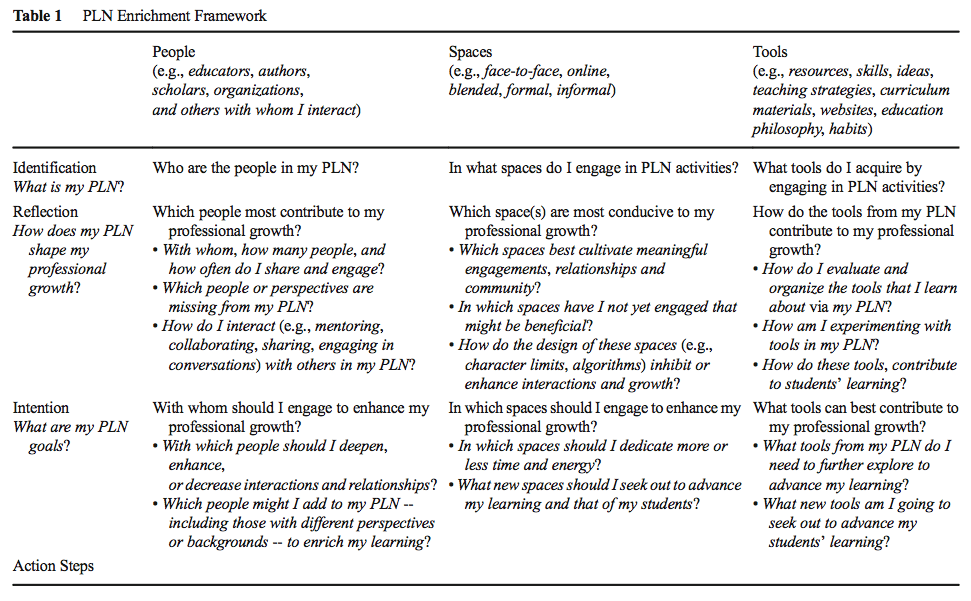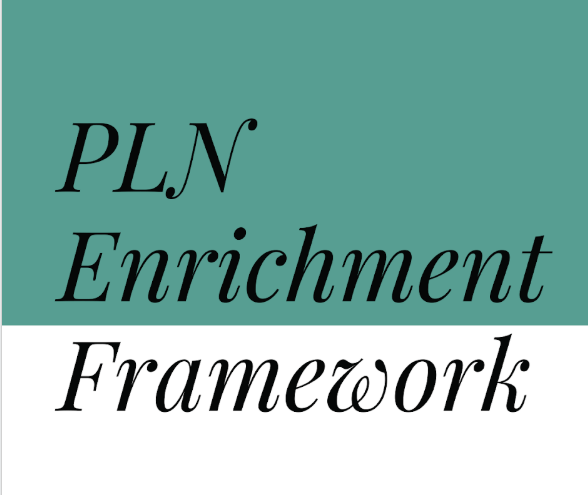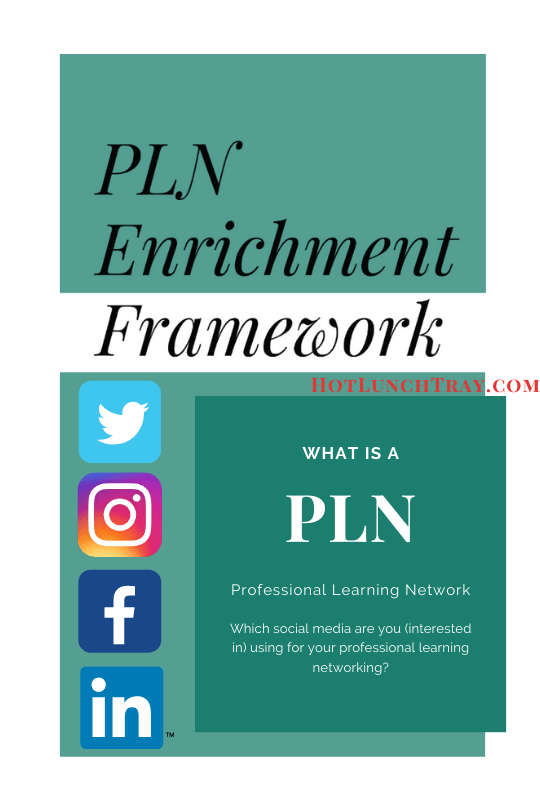Social Media has become an embedded part of every day, sometimes do not intentionally use it. We may use it without thought or post something incendiary, or we may even overshare. I challenge you to step through this PLN Enrichment Framework with me and your favorite social media account. Let’s discover how we are doing as professionals within our PLN.
My professional learning network (PLN) has been built over the last decade. It has been ten years since I created my Twitter account. I have been challenged by people am I getting everything I claim from Twitter? That is a good question. I know that I experience Twitter in waves lately, I am immersed in a discussion, topic, or chat and then I step back to observe. I want to take inventory of my Twitter account, use, and intentions.
During research, I found this useful framework and wanted to implement it. The PLN Enrichment Framework by Krutka, Carpenter, & Trust (2017) is an open-ended prompt in three domains: people, spaces, tools.

PLN Enrichment Framework (Krutka, Carpenter, & Trust, 2017)
I evaluated my interaction with my PLN through each of Krutka, Carpenter, & Trust (2017) three domains: people, spaces, tools. I used each domain and the associated prompts to create a rough sketch of those I follow on Twitter and where I can enhance my use of Twitter.
Here is a workbook for you to Copy and Complete, using these domains to identify where you can increase the usefulness of social media as your PLN:
People
Identification
People in my PLN:
I used FollowerWonk to look at the statistics of those I follow. Noteworthy is that the majority of those I follow:
- Social Authority for nearly 70% of those I follow is between 31-70.
- Of those I follow, I note who they follow. Nearly one-third of those I follow are following between 1-5,000. I have spikes of interest. 20% of those I follow, follow 100-500; there are 10% who follow 10,000-50,000 accounts.
- 90% of the accounts I follow are five or more years old.
- 55% of the accounts I follow have tweeted in the last hour-week; 72% in the last 30 days.
- 92% of the tweets of those I follow are in English.
Reflection
People who most contribute to my professional growth:
The social authority of those I follow aligns well with my own level of social authority. I am in a social media zone of proximal development, being at 59 and most of those I follow are between 31-70, learning from those who are as engaged as I am on Twitter.
Nearly one-third of those I follow are following between 1-5,000; this is comparable to those I follow and gives me a feel for their level of engagement with their Twitter feed. Notably, I have spikes of interest. 20% of those I follow, follow 100-500; I predict these are new to Twitter users in my school district who may only be following people they know within the district. Of those I follow, there are 10% who follow 10,000-50,000 accounts; I do not see these people as engaged in Twitter as a PLN experience. They may be organizations or those educators trying to make a PLN that purchases conference engagements or large subscriptions. I predict these users would utilize hashtags or lists versus their Twitter feed to engage with others.
Intention
Sharing and engaging:
I am following active educators who are engaging on Twitter. I wonder if I am engaging or just promoting my website sometimes. I want to maintain these relationships and may need to rethink what I am sharing if I want to maintain active educators on Twitter.
People missing from my PLN:
I want to connect with more educators who are creating K12 online content, delivering K12 online content, and those that are authoring new ways to deliver that content to students. I am not sure which niche that is yet, but I am looking for those people.
Interaction with my PLN:
Over the last year, since starting back to school, most of my tweets have been via the WordPress Plugin “Revive Old Posts.” While topical to those I consider my PLN, they are just tweets to existing blog posts and not often engaging portions of dialog. I want to scale those tweets back; that should make my less-automated tweets more authentic.
Spaces
Identification
In which spaces do I engage in PLN activities?
#ETCoaches, #TECHtalkGA, #EdCampNEGA, #BLinAction, #HallCoChat are my hallmark Twitter chats and hashtags. I have been most faithful to #ETCoaches lately. EdTech Coaches has a nice cross-platform PLN which fits me very well. Twitter is always my first stop, but closely behind is the discussion board behind the ISTE PLN login. For years I have enjoyed the blogs of others in this PLN, slow chat book studies, and meeting face-to-face at ISTE conferences. A resurgence in the idea of a local district hashtag #HallCoChat is actually based on the slow chat model of #ETCoaches. When #HallCoChat was first started, educators in the district were not aware of the power fo Twitter like they appear to be now.
Reflection
What spaces are most conducive to my personal growth?
I have learned the most from #ETCoaches because that is the most active and sharing community I belong to right now. I think there is strength in the cross-platform model for creating a thriving PLN.
Which spaces best cultivate meaningful engagements, relationships, and community?
Both #TECHtalkGA and #EdCampNEGA are often short-lived engagements for me. It is notable that I can use the hashtag and find connections, answers, what I am looking for rapidly. I feel both sleepers and may grow into larger connections for me in the future.
In which spaces have I not yet engaged that might be beneficial?
I have left the Georgia Educational Technology Conference and Florida Educational Technology Conference hashtags/connections largely uncultivated. I see these as potentially useful like #TECHtalkGA and #EdCampNEGA for short, but powerful narrow in scope interactions.
How do the design of these spaces (e.g. character limits, algorithms) inhibit or enhance interactions and growth?
I adopted the more restrictive (previous) 140 characters long ago and still find Twitter easy to navigate. The immediate responsiveness and connection creating is what I find most appealing about this platform.
Intention
In which spaces should I engage to enhance my professional growth?
I think there is more room for my engagement within #ETCoaches. They offer more formal leadership options than other PLNs and the connections are varied with levels of responsibilities in other districts. I am learning so much about the early implementation of online and blended professional learning and K12 online and blended education that I cannot disengage from this PLN.
In which spaces should I dedicate more or less energy?
I also think it is an optimal time to re-engage the #HallCoChat PLN as more local educators are more eager to tell their classroom or school story via Twitter. The district has newly embarked on a literacy initiative and my workgroup and like-minded district educators can show how to use Twitter to share and generate new ideas around this initiative.
What new spaces should I seek out to advance my learning and that of my students?
I want to broaden my horizons and see if there are other PLNs on Twitter I do not know about yet. Likewise, how can I enhance and platform opportunities for the existing ones? I so enjoy #ETCoaches, maybe that experience can be emulated and broaden other groups to a wider, richer membership?
Tools
Identification
What tools do I acquire by engaging in PLN activities?
I have found an abundance of strategies, resources, websites through my PLN which have helped me through questions and wonderings. More importantly, I have found people who I can ask direct questions to – and for whatever reason they are willing to answer honestly and helpfully.
Reflection
How do the tools from my PLN contribute to my professional growth?
Any of the strategies and resources have moved em past stops in my professional thinking where I was held back by my limited understanding or thinking about an idea.
How do I evaluate and organize the tools that I learn about via my PLN?
I try to understand to the best of my ability how the tool was implemented and what issue it solved form the person sharing it and then I evaluate if that tool could fit into my situation.
How do these tools, contribute to students’ learning?
Once I can evaluate the implementation possibilities of a tool I share it with every educator I know in need. I trust it makes it to the classroom, but at least it makes it to my children.
Intention
What tools can best contribute to my professional growth?
Ideas and strategies and how they are well-implemented always make a difference to my practice.
What tools from my PLN do I need to further explore to advance my learning?
I should further explore websites that my PLN shares, but I become easily distracted by talking about the implementation of strategies; I can consciously work on that going forward.
What new tools am I going to seek out to advance my students’ learning?
Maybe I can look for a checklist or predetermined variety of resource tools to widen my type of tool I often look for to solve issues.
I would love to hear about your evaluation of your PLN – and hope that you add me to yours!
Please feel encouraged to leave your social media accounts below along with any comments on your PLN evaluation.
Here is my workbook for you to Copy and Complete, and let me know if you uncover anything useful in your examination of your interactions with your own PLN.
References
Krutka, D., Carpenter, J., & Trust, T. (2017, May). Enriching Professional Learning Networks: A Framework for Identification, Reflection, and Intention. TechTrends: Linking Research & Practice to Improve Learning, 61(3), 246-252. doi:10.1007/s11528-016-0141-5







3 Pingbacks